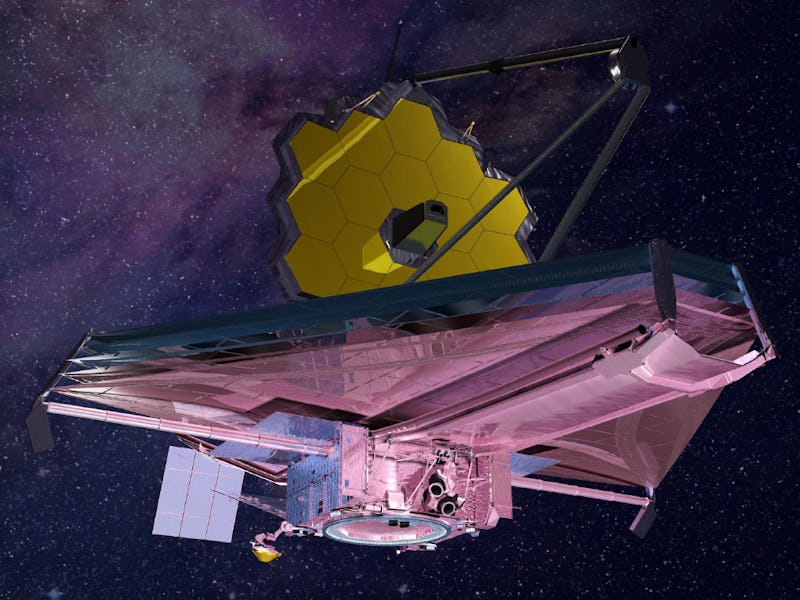Behold! The James Webb Space Telescope is on the launchpad
In development since the 1990s, it's finally a reality.

After years of anticipation, it seems that the largest space telescope ever is finally ready to launch into space.
On the morning of December 23, NASA’s flagship James Webb Space Telescope (JWST) was rolled slowly to its launchpad at the Arianespace ELA-3 launch complex in French Guiana, where it will await a ride into space. The short journey marks the end of Webb’s terrestrial travels and the beginning of a much longer and colder trip to its future home 1 million miles from Earth.
Photos released this morning show the Ariane 5 rocket standing tall on the launchpad, with JWST tucked away inside the nosecone. The sky is cloudy, but the weather, cited as the reason for a previous launch delay, appears good for the moment.
The faring of the Ariane 5 rocket that will take the James Webb Space Telescope to its perch in space.
Sitting safely on the launchpad, JWST will undergo a few final tests to make sure the rocket and telescope are ready for launch, NASA said in a short press release this morning. The rocket carrying Webb is scheduled to launch on December 25, at 7:20 AM EST (12:20 UTC).
It’s been a long time coming. First proposed decades ago, the telescope’s design and development were delayed multiple times, pushing the launch back by years. Even with the $10 billion telescope finished, more setbacks, including a loose clamp and scheduling conflicts at the spaceport, moved the launch from a date in the fall of 2021 to nearly the end of the year.
But now, bolted securely atop its launch vehicle, JWST is finally ready for its big moment. The space telescope is a joint project of NASA, the European Space Agency, and the Canadian Space Agency.
Earth’s atmosphere blocks some wavelengths of light and creates subtle distortions that can ruin images of far-away galaxies and other deep-space objects. That’s why telescopes like Hubble and JWST are launched into orbit, where they can obtain crystal-clear views of space. But it also means their systems must work perfectly. Though Hubble remained in orbit around Earth, where it could be repaired, albeit with great effort, Webb will be too far away to service.
The end of the journey for the James Webb Space Telescope.
It also means JWST still has a long journey ahead of it. After launch, the telescope will separate from the rest of the rocket and set a course for the second Lagrangian point, an invisible perch in space where the gravity of the Earth and Sun cancel each other out. During the journey, the telescope’s tennis-court-sized sunshield must unfold, followed by its primary mirror, a disc of gold-plated hexagons 21 feet in diameter. These complex maneuvers must happen perfectly, or the invaluable space telescope might not work at all.
Once in place at the L2, Webb will spend about six months turning itself on and stretching its metaphorical wings. After all the systems have been powered up and tested, scheduled to happen in early summer 2022, astronomers worldwide will be rewarded for years of eager anticipation.
The rollout of the Webb telescope’s journey to its launchpad.
More powerful than any previous telescope, including its predecessor Hubble, JWST will be able to detect faint glimmers of faraway light that are nearly as old as the universe itself. That ability will let astronomers peer back 13.5 billion years to when the universe was still young and stars and galaxies had just begun to form — a time invisible to us until now.
The suite of infrared instruments onboard the telescope will also allow scientists to look into the atmospheres of faraway exoplanets in search of the signs of life, as well as through the obscuring clouds of dust that hide still-forming stars and planets from view. Those super-powered abilities will hopefully result in brand-new insights into the structure and ongoing life of our universe, and decades of new discoveries.
You can watch the James Webb Space Telescope launch on Christmas Day on a NASA livestream on their website, NASA TV, or the NASA YouTube channel. If all goes well it will be a fitting present for scientists and space lovers the world over. Let’s hope Santa’s feeling nice this year.
The final steps to launchpad.